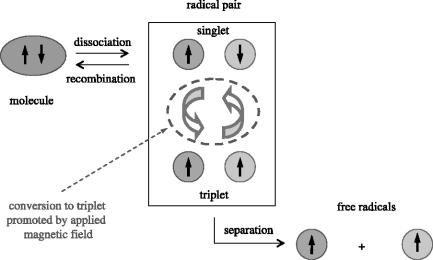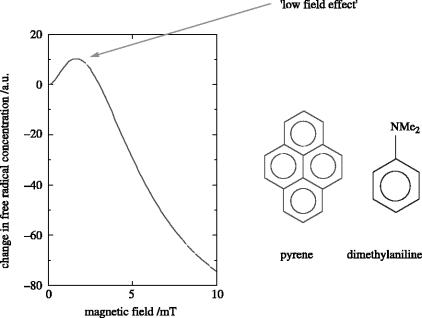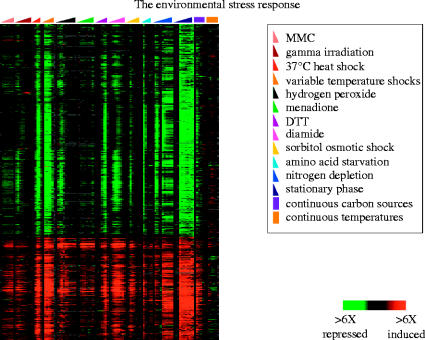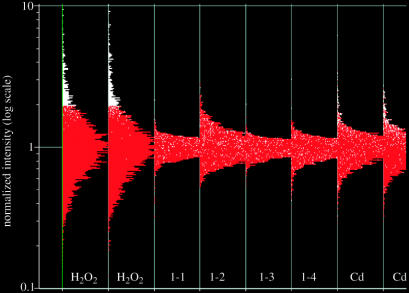Abstract
Electric power is an essential commodity of the developed world, and is critical to the continuing progress of our technology-based society, as well as to the growth of less privileged societies. In contrast to its overwhelming benefits, there is a suspicion that the magnetic component of the electromagnetic fields (EMFs) associated with power distribution and electrical appliances has adverse health effects, especially a small increased incidence of childhood leukaemia. The possibility that environmental EMFs represent a health hazard has serious economic implications for government, the electricity industry and society, as well as raising several profound scientific challenges, including, in particular, biophysical mechanisms, experimental replication and scientific uncertainty. These challenges are explored in relation to the experiences of the EMF Biological Research Trust, a UK medical research charity which funds basic research on the biological effects of extremely low-frequency electromagnetic fields (ELF-EMFs). As judged from these experiences, at the present time there is no compelling experimental evidence that environmental ELF-EMFs induce biological responses.
Keywords: extremely low-frequency electromagnetic fields, radical-pair mechanism, environmental stress responses, yeast gene expression, scientific uncertainty
1. Preface
When one admits that nothing is certain one must, I think, also admit that some things are much more nearly certain than others.
(Bertrand Russell 1947)
A recurrent theme of this lecture is scientific uncertainty.
It is commonplace in the biological sciences that experimental conclusions do not fall neatly into the ‘yes’ or ‘no’ compartments which are beloved by the media, but occupy a space in the spectrum of uncertainty that spans between those two compartments. The actual location of a particular conclusion depends on a variety of factors, especially the quality of the data and the critical perception of the investigator. Such factors will prove crucial to the derivation of an answer to the question posed in the title of this lecture.
2. Review of the field
The sight of high-voltage power lines, strung between pylons, marching across the countryside, is a familiar scene. Some of us criticize this scene as being an intrusion upon the landscape, but all of us embrace the multiple benefits that come with electric power. It is no exaggeration to say that our western society is dependent on it, as is evident from the consequences of the recent large-scale ‘blackouts’ in Italy, London and the USA. It is not the purpose of this lecture to extol the benefits of electric power, but to focus on a potential specific downside, namely, whether the electromagnetic fields (EMFs) associated with electric power distribution have adverse health impacts. This important question has been debated by both scientists and the public for a number of years. The debate has been often heated and frequently acrimonious. My judgement of the status of the debate is that the question has not yet been resolved in a satisfactory way, and that the answer is shrouded in uncertainty.
In this lecture, I will describe how one group of scientists, namely the EMF Biological Research Trust,1 has responded to the challenge of this uncertainty. First of all, though, I need to point out a potential conflict of interest, which arises because the Trust is funded by donations from National Grid Transco plc. The Trust has responded to this potential conflict by ensuring that all scientific decision-making is invested in an independent scientific advisory committee comprising members of the UK's academia. Further, grantholders are encouraged to publish the results of their work in peer-reviewed journals.
The Trust's work needs to be judged relative to the following scene-setting perspectives. First, the characteristics of the EMFs. The environmental EMFs which concern us are those associated with electric power distribution. Typically, they are associated with above- and underground high-voltage cables, as well as household electrical circuits and appliances. These fields oscillate with a very low frequency of 50–60 Hz and are weak, having a strength of less than 100 μT. They are commonly referred to as extremely low-frequency EMFs, or by the abbreviation ELF-EMF. In order to put such fields into perspective, a comparison with the Earth's magnetic field is valuable. The Earth's field differs in that it is static as distinct from oscillating, but its strength, which in the region of the UK is about 50 μT, is very similar. The fields associated with mobile phones and mobile phone masts are clearly differentiated by the fact that they oscillate with a very much higher frequency. Thus, they do not concern us.
The second scene-setting perspective concerns the evidence in support of a link between exposure to ELF-EMFs and an adverse affect upon human health. The most satisfying evidence has been provided by epidemiological studies. The most direct approach to determining whether an environmental factor impacts upon human health is to look within the population for an association of the factor with a disease. The quality of such epidemiological studies depends critically upon two variables; first, the strength of the association of the factor with the condition and, second, the number of people who were studied in order to determine whether or not an association exists. The weaker the association of the factor with the condition, then the larger the number of persons who need to be incorporated into the study in order to reveal the association.
During the last 25 years, multiple epidemiological studies have been conducted in order to explore whether exposure to ELF-EMFs is linked to a human condition. A diverse spectrum of conditions were targeted, including suicide, miscarriage and mental disease, although the majority of these studies focused on cancer and, in particular, leukaemia and brain cancers. In my judgement, up to the year 2000, these multiple studies provided no satisfying positive or negative outcomes. However, this lack of clarity delivered one clear message, namely, that if ELF-EMF exposure is associated with an adverse human condition, then this association must be weak. In the year 2000, the publication of two independent studies caused a significant shift in opinion (Ahlbom et al. 2000; Greenland et al. 2000). The very important difference between these and the previous studies was the very much greater number of persons studied. This was achieved by pooling a number of previous studies and re-analysing the corporate data. Such an approach is known as a meta-analysis and is now commonplace in epidemiology; it has the notable benefit of revealing weak associations. The two independent meta-analyses delivered essentially the same outcome, which is summarized in figure 1. This shows that continuous exposure over a long period to ELF-EMFs of average field strength greater than 0.4 μT is associated with a doubling of the relative risk of childhood leukaemia.
Figure 1.
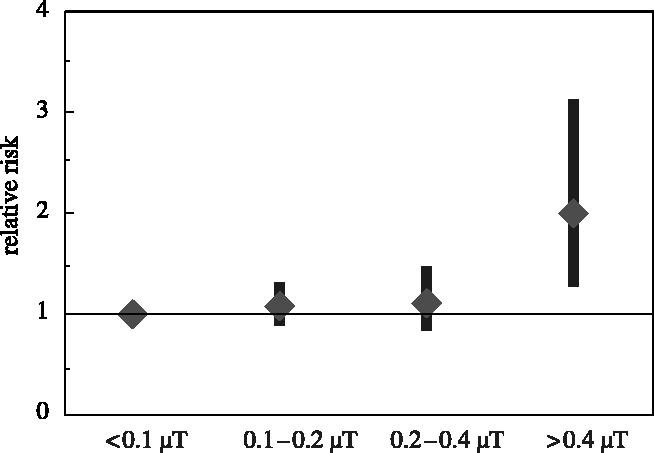
The relative risk of childhood leukaemia in relation to the average strength of the ELF-EMF to which the subject was continuously exposed. This paper is based on the data of Ahlbom et al. (2000). (I am grateful to Dr John Swanson (National Grid Transco plc) for the figure.)
Before discussing this conclusion in terms of its wider perspective, I need to address an important consequence of these data for society, namely, the fraction of the UK's houses that are exposed to ELF-EMFs of average strength greater than 0.4 μT. Figure 2 shows a distribution curve of the number of houses versus the strength (in nT) of their ELF-EMFs. It is evident that the vast majority of the UK's houses have ELF-EMFs whose strength is some two orders of magnitude less than 0.4 μT. However, the curve has a significant tail, and there are a number of houses exposed to an ELF-EMF above 0.2 μT (i.e. 200 nT). How many houses or persons come within this category? According to Swanson & Kaune (1999), about 1% of the UK housing stock has exposures greater than 0.2 μT, whereas, in the USA, the proportion is some 10 times larger. Alternatively, the National Radiological Protection Board has estimated the number of persons to be about 300 000. That is, some 300 000 persons apparently have a doubling of the relative risk of childhood leukaemia, although, of course, not all of these people are children.
Figure 2.
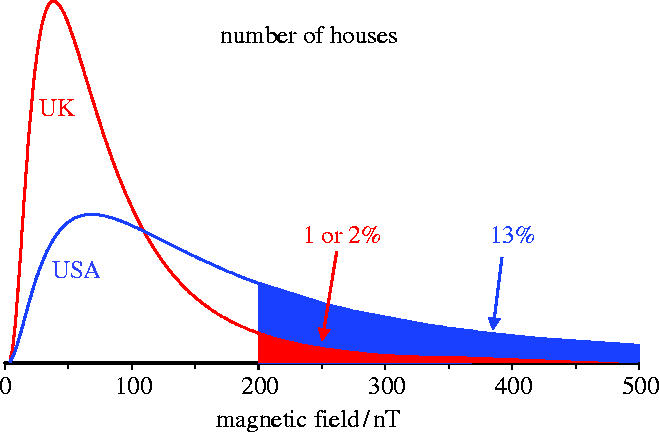
Distribution curves showing the average strength of the ELF-EMF to which individual houses are continuously exposed in the UK and the USA. (I am grateful to Dr John Swanson (National Grid Transco plc) for the figure.)
To return to the perspective of the results of the two meta-analyses. First, 0.4 μT represents a very weak field strength, especially when compared with the Earth's 100 fold stronger static magnetic field, to which all of us are exposed all the time. Second, a doubling of the relative risk represents only a weak association in epidemiological terms. For example, Doll & Hill's (1964) epidemiological study of the link between smoking and lung cancer revealed at least a 10 fold greater relative risk. To express a doubling of the risk of childhood leukaemia in another way, this corresponds to an extra two cases each year in addition to the UK's annual average of 500 cases. Third, two scientific insights need to be factored into this discussion.
The first of these is that there is no known direct physical mechanism by which a field strength as low as 0.4 μT can invoke a biological response. That is not to say that such a mechanism does not exist, but if it does, we currently have no knowledge of it. The second insight concerns the quality of the data and conclusions derived from a host of laboratory experiments that have sought to determine whether ELF-EMFs induce biological responses. In the Trust's judgement, these collective experiments do not provide any satisfying evidence in support of an affirmative answer. I appreciate that this judgement is controversial. Later in this lecture, I will discuss some of the experiments on which this judgement is based.
To summarize, assuming the above perspectives are valid, then the epidemiological results are not underpinned by either a defined physical mechanism or prescribed biological responses. In other words, there is no established causal mechanism to support the results. When this analysis is combined with the fact that the epidemiology revealed a weak association only, then it is apparent that the results are no more than indicative. In spite of this important qualification, the epidemiological data represent a baseline which must be embraced and, in turn, progressed to a position of greater certainty (either positive or negative). Meanwhile, the data have stimulated two significant responses. The International Agency for Research on Cancer has recently classified ELF-EMFs as possibly carcinogenic (IARC 2002), whereas the UK's National Radiological Protection Board's recent revised guidelines suggest that ELF-EMF exposures of less than 100 μT would be safe for the general public (AGNIR 2001). These recommendations embrace the currently important ‘precautionary principle’ and represent science and society's response to the dilemma of uncertainty. Clearly, this situation is not ideal. How should scientists respond to the challenge of this particular uncertainty?
3. The Trust's response
The Trust was set up about ten years ago to fund basic laboratory research to explore whether ELF-EMFs induce responses. A key element of its strategy has been to restrict its support to the best scientists. However, implementation of this element represents a considerable challenge. Thus, the UK's best scientists are well supported and do not normally look to small funding agencies, such as the Trust. Further, they have their own interests, portfolios and agenda, which usually do not include environmental magnetic fields. I will highlight later in this lecture one way of circumventing this hurdle. Another key element is to subject all applications to rigorous independent expert review. In this respect, the Trust employs the same criteria as those of the Wellcome Trust or the Medical Research Council (MRC).
The work supported by the Trust falls into three categories.
4. A biophysical mechanism?
The motivation is to explore whether there is indeed a direct physical mechanism by which weak magnetic fields could induce a biological response. Potentially, there are a number of possible mechanisms. The Trust has chosen to focus on whether magnetic fields perturb the level of free radicals in biological systems. Free radicals represent an ideal biological candidate for transducing a physical force, because they occur naturally, are highly reactive and are mutagenic in living cells. The work supported by the Trust (Professors Brocklehurst, Hore and McLauchlan and Dr Timmel; Oxford) was based upon previous theoretical and experimental studies which had led to the identification of the ‘radical-pair mechanism’ (Brocklehurst 2002) and the prediction of the so-called ‘low-field effect’ as a possible route to perturbing the concentration of free radicals in a biologically meaningful context (Brocklehurst & McLauchlan 1996; Timmel et al. 1998).
The radical-pair mechanism is illustrated in figure 3. The starting point is a molecule that can be split by natural forces to form a pair of free radicals, which are in a ‘singlet state’ having opposite electron spins. If these radicals remain in close contact with one another, then they readily recombine to form the original molecule; whereas, if they diffuse away from each other, they remain as free radicals. Radicals in the singlet state can interconvert to the ‘triplet state’, having parallel spins. Triplet state radicals are not able to recombine; so in time they diffuse away from each other and are free to react with a variety of other molecules/radicals. The theory predicts that an applied magnetic field perturbs the interconversion of the singlet and triplet states, resulting in an increase in the proportion of the triplet state, and thus the free-radical concentration.
Figure 3.
The radical-pair mechanism. This figure is derived from a collection of theoretical and experimental studies on magnetic-field effects (Brocklehurst 2002). (I am grateful to Professor P. J. Hore for the figure.)
While the description of the radical-pair mechanism represented a notable advance, there was a compelling need to prove the theory experimentally, as well as to confirm the predicted low-field effect. Figure 4 shows the results of a simple chemical experiment in support of the theory and the prediction. A mixture of pyrene and dimethylaniline exposed to a laser flash provided the free radicals, the yield of which was measured in the presence of an applied static magnetic field of increasing strength. (Note that the strength of the applied field was in the mT range.) The results showed that with the increasing strength of the field, the free-radical concentration (expressed in arbitrary units) initially increased to a maximal level before decreasing. The initial increase is commensurate with the predicted low-field effect (Timmel et al., unpublished observations).
Figure 4.
Demonstration of the ‘low-field effect’, whereby exposure to static magnetic fields causes an increase in the free-radical concentration. (Timmel et al., unpublished observations)
While this is a very encouraging outcome, there is an absolute requirement to progress this experiment in a number of directions. First, the biological perspective demands studies with much weaker fields, and ideally in the 10 μT range. However, the Science Advisory Committee perceives that if the radical-pair mechanism operates at such low fields, then the perturbation in free-radical concentration is unlikely to be sufficiently large per se to induce the magnitude of biological effects necessary to have an adverse effect upon human health. In other words, there is a need for an amplification step. Fortunately, a priori, there are a number of possible amplifiers, one of the most obvious being an enzyme system responsive to the increase in free-radical yield. A number of such potential systems exist. Second, and equally important, is to move forward from model chemical systems in solution to those which mimic biological systems, the ultimate endpoint being the biological cell. These are very challenging developments, but the Trust is committed to following both of the above pathways.
5. Replication experiments
In the experimental sciences, independent replication of results represents the gold standard. In particular, in those cases where an experiment purports to show a positive result which borders on uncertainty, there is an absolute requirement for this result to be reproduced in an independent laboratory before it can be claimed to be fact.
During the past 20 years, the possibility that ELF-EMFs induce biological effects has been explored experimentally by a host of laboratories, using a large variety of model cellular systems, with different targets and various readouts. Within this collection of experiments, the majority claim to have shown a positive response. Given the importance of replicating these experiments, the Trust has funded studies aiming to replicate the results of selected experiments from the above portfolio. In total, some six replication experiments have been carried out. In no instance has the original result been replicated. Two examples are presented here. First, Goodman & Shirley-Henderson (1991) have reported a series of experiments showing an increased expression of the transcription factor c-myc in response to the exposure of human leukaemia HL60 cells to EMFs. Their results received a significant amount of publicity and, as such, were an important candidate for replication. Work carried out by Lacy-Hulbert et al. (1995) in Professor Metcalfe's laboratory, however, failed to reproduce the original result. The results of a second high-profile study, which was especially important because the cell type used (B-lymphocytes) are tumorigenic in human leukaemia and which was published in the prestigious Journal of Biological Chemistry (Uckun et al. 1995), also were not replicated by Woods et al. (2000). Incidentally, a further independent US study also failed to confirm the original positive results (Miller et al. 1999).
These collective failures have caused the Trust to reconsider its strategy of funding replication experiments. One important reason is that the ongoing collaboration of the original investigator is essential in order to carry out the perfect replication experiment. In the Trust's experience, the original investigator always provided their full support initially, but at the first hint of failure to replicate, this interactive relationship was terminated, often in an acrimonious way. Without ongoing collaboration, it becomes impossible to categorically refute any claim that the replication attempt was imperfect. Another cogent concern was that a critical analysis of the original experiment often revealed flaws in procedures. Such flaws create a crucial dilemma. This is, in the Trust's opinion it is not permissible to fund poor science, but if you do not then the original experiment cannot be replicated!
There are a number of possible explanations for different laboratories deriving contrary results from what is apparently the same experiment. One explanation of particular interest is personal bias. Thus, it is commonplace for scientists to have a clear expectation of the outcome of an experiment and for this personal bias to be unconsciously incorporated within the experiment, so that the outcome is a self-fulfilling prophesy. Many scientists are aware of this and design the experiment so that the opportunities to express personal bias are minimized. In the case of ELF-EMF studies, this can be achieved by arranging for the exposure or not to the applied magnetic field to be blinded, and for the analysis of the results to be completed prior to breaking the code. This practice is a prerequisite for all work supported by the Trust.
Another bias which impacts upon the advance of knowledge in this field arises because the editors of scientific journals actively discriminate against the publication of negative results. As a result, the scientific literature does not reflect accurately the balance between positive and negative data.
6. Current scientific strategy
The Trust's revised scientific strategy, which aims to circumvent the above collective issues, comprises three strands. First, the previous focus on replication experiments has been deleted, although high-profile, experimentally satisfying reports of positive results will still be targets for replication. Second, EMF exposure has been formally repositioned as an environmental stress with an emphasis on comparing the biological consequences of such exposures with those induced by the other well known conventional environmental stresses. This strand has multiple potential benefits, including the ability to target the best UK scientists in the environmental-stress field, as well as being able to publish any negative results of magnetic-field exposure alongside positive data of other stresses in top-rank journals. The third strand is to promote the use of state-of-the-art technologies, especially in genomics and proteomics, in work funded by the Trust.
7. Technology advances
Progress in science depends upon new techniques, new discoveries and new ideas, probably in that order.
(Sydney Brenner)
This quotation encapsulates the scientific benefits which can accrue from the application of new technologies, including a possible paradigm shift in enlightenment.
The following project funded by the Trust provides an example of the implementation of the above strategy. The work was carried out by Professor N. Jones and colleagues at the Paterson Institute, in collaboration with the Sanger Centre at Cambridge. Professor Jones’ speciality is the use of yeast as a model organism to delineate environmental-stress responses in terms of the changes in gene expression, measured using microarray facilities (Chen et al. 2003). There are several reasons for the choice of yeast, including, at the time this work was funded, that its complete genome was available, whereas the human genome was incomplete. In addition, yeast has about 5000 genes only, compared with 30 000 or so for humans, enabling a simpler experimental procedure. The experimental protocol used is outlined in figure 5, and an example of the microarray readout of the changes in gene expression induced by several different stresses is visualized in figure 6. Analysis of the results showed that the collective stresses induced changes in the expression of a total of 1700 genes. Of these, about 140 genes were common to all stresses; thus, this group represents ‘markers’ of an environmental-stress response. Is the expression of the marker group altered by exposure to EMFs? The experiment is summarized in figure 7 and the collective microarray results, represented using a sophisticated software procedure in a more definitive so-called ‘Christmas tree’ form, are shown in figure 8. In the positive control (exposure to H2O2) represented in the two left-hand columns, the marker genes are represented by the outlying spots, both above and below the centre line. The distribution of these spots for the EMF-exposed and sham experiments is represented in the middle four columns and for a further positive control (exposure to Cd++) in the two right-hand columns. It is evident that in the middle four columns all the spots are randomly distributed and that there is no detectable difference in pattern between the exposed and sham samples. That is, there was no evidence for the EMF exposure having induced any gene-expression changes. This conclusion has a number of qualifications. These experiments were carried out using static magnetic fields within the range 200–1000 μT; there is the possibility that oscillating fields would have had a different effect. Second, the sensitivity of the microarray procedure used is such that a gene-expression change of less than 20% would not have been detected. Also, yeast may not be a suitable model for human responses to EMFs. Another possibility is that EMFs are not a conventional environmental stress and act via a different pathway, which does not depend on gene-expression changes. Although this seems unlikely, it warrants exploration by monitoring the yeast samples for changes in protein expression. This is currently being carried out by Professor M. Waterfield at the Ludwig Institute in London. Meanwhile, until these qualifications have been resolved, the failure to detect any gene-expression changes in yeast exposed to magnetic fields seriously questions the premise that EMFs induce biological effects.
Figure 5.
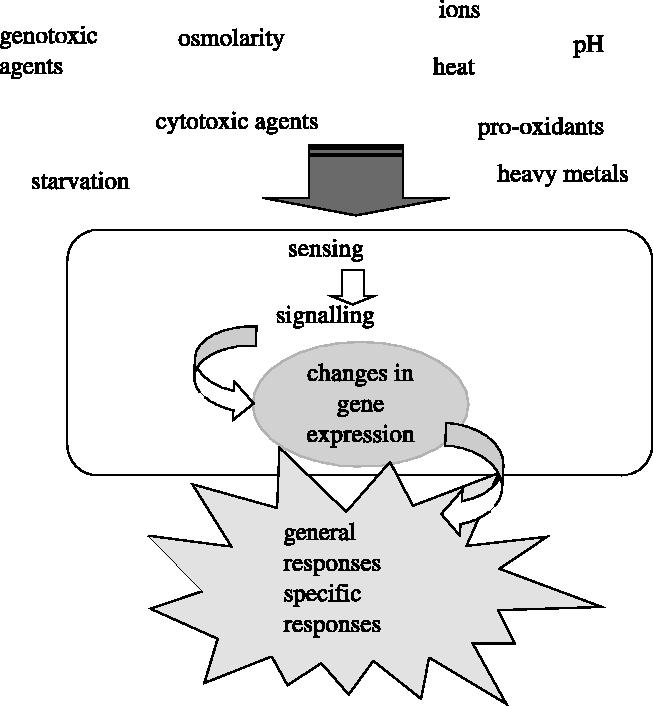
Outline of experiments using yeast to study the impact of environmental stresses on gene expression. (I am grateful to Professor N. Jones for the figure.)
Figure 6.
Microarray analysis of changes in gene expression induced in yeast by various environmental stresses. Decreases and increases in gene expression are represented in green and red, respectively; the extent of the changes up to a maximum of sixfold being indicated by the intensities of the colours. (I am grateful to Professor N. Jones and Dr Jürg Bähler for figures 6 and 8).
Figure 7.
Experimental protocol for determining whether exposure of yeast to electromagnetic fields induces changes in gene expression. (I am grateful to Professor N. Jones for the figure.)
Figure 8.
Gene-expression changes in yeast exposed to either magnetic fields or ‘sham-exposed’. The changes are expressed in the so-called ‘Christmas tree’ format (Chen et al., unpublished observations). The pairs of columns at the far left and far right represent positive controls exposed to H2O2 and Cd++, respectively, in duplicate. The four central columns represent exposure to either to 1000 μT static magnetic fields for 60 min or sham-exposed in duplicate. No consistent twofold activation or repression of genes was observed in the sham or exposed samples. Therefore, the results do not show any measurable variation that would be consistent with a group of genes being specifically altered in transcription as a result of magnetic-field exposure.
8. Epilogue
It is a characteristic of science that the full explanations are often seized, in essence, by the percipient scientist, long in advance of any possible proof.
(John D. Bernal 1967, p. 251)
This quotation encourages me to express my perceptive answer to the question, ‘Are ELF-EMFs a health hazard?’ The current epidemiological data represent the baseline, namely, an indication of a weak association only between ELF-EMF exposure and childhood leukaemia. The way forward to the resolution of this epidemiology uncertainty lies with defining a mechanism by which very weak ELF-EMFs could induce a biological response, and with a clear demonstration of actual reproducible biological responses. I am not aware, at the present time, of any satisfying experimental evidence in support of the view that ELF-EMFs do induce such responses. An important question is whether ELF-EMFs affect normal human cells. In my opinion, normal cells are very unlikely to be affected, although it is possible that cells altered as a result of genetic predisposition, combined with environmentally induced changes, are sensitive. If such cells exist, then the most likely place to find them would be within the pathway of cellular changes leading to childhood leukaemia.
Acknowledgments
I acknowledge my profound debt of gratitude to all the past and present members of the Trust's Scientific Advisory Committee. Also, to all the scientists funded by the Trust and especially to those laboratories whose work has been referred to in this lecture. Finally, to Dr John Male, the trust's Administrative Secretary, who has provided invaluable help with the preparation of both the lecture and this manuscript.
Endnote
The EMF Biological Research Trust is a UK-based medical charity which funds basic research on the biological effects of the environmental extremely low-frequency electromagnetic fields (ELF-EMFs) associated with electric power distribution. It is funded by donations from National Grid Transco plc. The research programme is administered by a Scientific Advisory Committee which is totally independent of the electricity transmission industry. The Trust encourages publication of results of the work it funds and the content of such publications is the sole responsibility of the grantholders.
References
- AGNIR. Documents of the NRPB. vol. 12, no. 1. Oxon: National Radiological Protection Board; Chilton: 2001. ELF Electromagnetic fields and the risk of cancer: Report of an Advisory Group on Non-ionising Radiation. [Google Scholar]
- Ahlbom A, et al. A pooled analysis of magnetic fields and childhood leukaemia. Br. J. Cancer. 2000;83:692–698. doi: 10.1054/bjoc.2000.1376. [DOI] [PMC free article] [PubMed] [Google Scholar]
- Bernal J.D.The origin of life1st edn.1967OH: World; Cleveland [Google Scholar]
- Brocklehurst B. Magnetic fields and radical reactions: recent developments and their role in nature. Chem. Soc. Rev. 2002;31:301–311. doi: 10.1039/b107250c. [DOI] [PubMed] [Google Scholar]
- Brocklehurst B, McLauchlan K.A. Free radical mechanism for the effects of environmental electromagnetic fields on biological systems. Int. J. Radiat. Biol. 1996;69:3–24. doi: 10.1080/095530096146147. [DOI] [PubMed] [Google Scholar]
- Chen D, Toone W.M, Mata J, Lyne R, Burns G, Kivinen K, Brazma A, Jones N, Bähler J. Global transcriptional responses of fission yeast to environmental stress. Mol. Biol. Cell. 2003;14:214–229. doi: 10.1091/mbc.E02-08-0499. [DOI] [PMC free article] [PubMed] [Google Scholar]
- Doll R, Hill A.B. Mortality in relation to smoking: ten years' observations of British doctors. Br. Med. J. 1964;1:1399–1410. doi: 10.1136/bmj.1.5395.1399. (see also pp. 1460–1467) [DOI] [PMC free article] [PubMed] [Google Scholar]
- Goodman R, Shirley-Henderson A. Transcription and translation in cells exposed to extremely low frequency electromagnetic fields. Bioelectrochem. Bioenerg. 1991;25:335–355. [Google Scholar]
- Greenland S, Sheppard A.R, Kaune W.T, Poole C, Kelsh M.A. A pooled analysis of magnetic fields, wire codes, and childhood leukemia: Childhood Leukemia–EMF Study Group. Epidemiology. 2000;11:624–634. doi: 10.1097/00001648-200011000-00003. [DOI] [PubMed] [Google Scholar]
- IARC. Static and extremely low-frequency (ELF) electric and magnetic fields: IARC monographs on the evaluation of carcinogenic risks to humans. vol. 80. International Agency for Research on Cancer; Lyon: 2002. [PMC free article] [PubMed] [Google Scholar]
- Lacy-Hulbert A, Wilkins R.C, Hesketh T.R, Metcalfe J.C. No effect of 60-Hz electromagnetic fields on myc or β-actin expression in human leukaemic cells. Radiat. Res. 1995;144:8–17. [PubMed] [Google Scholar]
- Miller S.C, Haberer J, Venkatachalam U, Furniss M. J. NF-kB or AP-1 dependent reporter gene expression is not altered in human cells exposed to power line frequency magnetic fields. Radiat. Res. 1999;151:310–318. [PubMed] [Google Scholar]
- Russell B.Am I an atheist or an agnostic?1947KA: Haldeman-Julius; Girard [Google Scholar]
- Swanson J, Kaune W.T. Comparison of residential power-frequency magnetic fields away from appliances in different countries. Bioelectromagnetics. 1999;20:244–254. doi: 10.1002/(sici)1521-186x(1999)20:4<244::aid-bem5>3.0.co;2-2. [DOI] [PubMed] [Google Scholar]
- Timmel C.R, Till U, Brocklehurst B, McLauchlan K.A, Hore P. Effects of weak magnetic fields on free radical recombination reactions. J. Mol. Phys. 1998;95:71–89. doi: 10.1080/09553000050176270. [DOI] [PubMed] [Google Scholar]
- Uckun F.M, Kurosaki T, Jin J, Jun X, Morgan A, Takata M, Bolen J, Luben R. Exposure of B-lineage lymphoid-cells to low-energy electromagnetic fields stimulates Lyn kinase. J. Biol. Chem. 1995;270:27 666–27 670. doi: 10.1074/jbc.270.46.27666. [DOI] [PubMed] [Google Scholar]
- Woods M, Bobanovic F, Brown D, Alexander D.R. Lyn and Syk tyrosine kinases are not activated in B-lineage lymphoid cells exposed to low-energy electromagnetic fields. FASEB J. 2000;14:2284–2290. doi: 10.1096/fj.00-0164com. [DOI] [PubMed] [Google Scholar]



